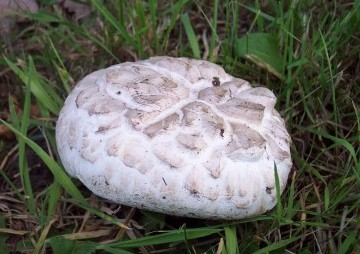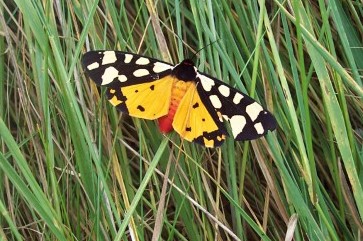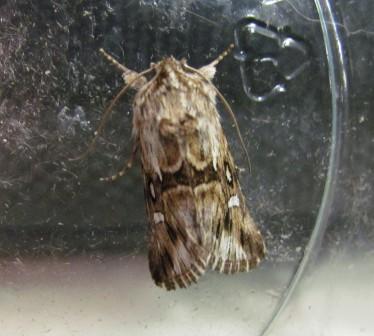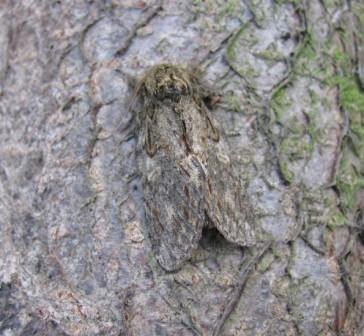Further Notes form Blue House reserve
May 28th : Blue House Farm EWT Reserve, North Fambridge. Clusters of large white objects littering the grazing marsh on the reserve appeared, at a distance, to be Giant Puffballs but closer inspection revealed them to be Agaricus bernardii.  This species is easily recognised by its deeply fissured cap and the extremely firmly textured flesh (yielding but little when pressed hard) which turns bright pinkish-red when cut. As for the smell it is described as "fishy" by Phillips (1988) but as "carbolic, metallic or with a dung component" by Noordeloos (2001). This is irrelevant to me, as I have no sense of smell, but it does illustrate the problems faced by amateur mycologists like myself when trying to identify a species using smell and a variety of text books! This species is traditionally associated with saline coastal grazing marshes but like many vascular plant species it has learned to exploit the salt splash zone along roadside verges and is probably commoner in this habitat nowadays than along the coast. The only record on the BMI database for Essex was made by E.W. Brown on a roadside verge near Grays Rugby Club in 2004 but this is surely not a true reflection of its status in the county. The photo, above was taken at Fryerning Green, Ingatestone in 2009.
The hot weather between May 22nd and 26th finally seems to have kick started the spring for invertebrates. Previously, during walks in the countryside, the fields and hedgerows looked green and burgeoning but it was a struggle to find much in the way of insect life apart from a few early spring bees. Today, my weekly butterfly transect on Blue House produced 91 Common Blues, 70 Small Heaths and 27 Small Coppers along with a fine array of day flying moths such as Latticed Heath, Mother Shipton, Burnet Companion, Small Yellow Underwing, Yellow Belle, Silver Y and Cream-spot Tiger  . Hairy Dragonflies (6) and Four-spotted Chasers (6) were also on the wing for the first time together with small numbers of Large Red, Azure, Common Blue and Blue-tailed Damselflies. My first record for Small Heath on the reserve this spring was on May 19th and Common Blue on 22nd, both about ten days later than in both 2008 and 2009. Better late than never though. Spring at last! National Moth Night at Epping
May 16th : Along with Andy McGheeny, Martin McCleary and Anthony Harbott I helped out with a National Moth Night event at Epping Field Centre. Around a dozen members of the public attended and, as usual, I was pleasantly surprised by the level of interest shown. With persistent north-east winds, sunny days and cold nights the spring had been one of the poorest on record in my garden at Ingatestone, where I have been trapping regularly for around twenty years; thus I was not too hopeful that we would catch much, especially as there were clear skies at dusk and a predicted temperature of around 4`C. Five traps were set around the centre and by the end of the evening our tally had struggled to thirteen macro moths of nine species. Still, there were one or two nice things among them including Water Carpet, Orange Footman and Nut Tree Tussock but just as much excitement was caused by the commoner but brightly coloured Brimstone Moth. All in all, a successful evening. The most remarkable capture, however, was made by Martin McCleary in his Epping garden the previous evening. This was a Toadflax Brocade (top picture)  , a European species that is on the edge of its range in Britain and which did not colonise our shores until the early 1950s. It is still largely confined to shingle beaches at Dungeness and adjacent areas although there have been a number of records from the Dovercourt area during the early part of this decade (Goodey 2004, p.293) and may possibly be colonising the beaches there. Shingle ridges are in short supply at Epping but the caterpillars' food plants, Common Toadflax and, increasingly, Purple Toadflax are not. Even so it is a totally unexpected record but, amazingly, Steve Wilkinson caught one in his garden at Chelmsford on the very same night! A species on the move it would appear. Coincidence? A fluke? Our warming climate? Time will tell. The best I could do in my own garden at Ingatestone (where I left a UV trap set all night) was a single Great Prominent (second picture)  , a species scarce in Essex and largely confined to mature oak woodland. A single moderate sized oak in a neighbour's garden seems to have been the lure for this one. Nature red in Beak and Claw
Blue House Farm EWT Reserve. May 5th. During the autumn of 2009 the EWT deepened and extended the creeks and runnels which crisscross a sixty acre field on the reserve known as The Flood. The aim was to extend the area flooded in winter, both for wintering wildfowl and nesting wetland birds such as the Lapwing. This work was made viable by the installation, the previous autumn, of a wind pump to replace the expensive and inefficient petrol pump that had to be used previously. The result was success beyond expectations; one visitor liking the improved flooded area to a min-East Scrape; any comparison with Minsmere being high praise indeed! Breeding wildfowl and waders also gave it their approval, an increase being noted for several species. At the onset of nesting on any wetland reserve their is always trepidation regarding the outcome as predation can often be very high. With wetland birds being increasingly squeezed into reserves, and largely absent from the wider landscape, a fox in the chicken run situation can develop, and a few visits from Reynard can devastate a breeding population; indeed, according to a recent RSPB investigation it is the one predator (other than crows in localised areas) that can have a serious long term affect on wader numbers. Fortunately, night-time surveys by the warden at Blue House have revealed few foxes so far this spring, a situation confirmed by neighbouring landowners. Famous last words!
Alas, despite the absence of their main predator it would seem that the wetland birds are finding it difficult to live in peace and harmony. In early April an Avocet was seen to kick the eggs out of a Lapwing nest and take over the small muddy island on which it was breeding. After replacing it with its own nest it in turn received its comeuppance when a Coot filched its only egg, not bothering to eat it but simply dropping it into the water nearby. A few days later another Avocet nest fell foul of a Coot; I arrived in the hide overlooking the flood just in time to see one making off with the last of a clutch of four eggs. I never have liked the ruddy things! Another Avocet nest was almost certainly trampled by a Grey Lag Goose, a species with large flat feet activated by a small brain. I strongly suspect that Coots have also been behind the demise of one or two Lapwing nests and also the homicide of their chicks as Lapwings are more selective than Avocets in the interlopers they will attack and at Blue House this spring they reserve a particular venom for any Coot that comes within range of their eggs or young. A good example of this selectiveness occurred on May 5th when I watched a pair of Lapwing nesting in a nearby field single out a lone crow among a flock of seventy rooks for a bit of grievous bodily harm! Anyway, these observations suggest that whereas it is usually Reynard who gets the blame (often correctly) for predation on wetland reserves there are other, less expected, culprits as well. Last year, on another Essex reserve, I even heard rumours of an Oystercatcher swallowing an Avocet chick. The current situation on The Flood has not arisen before as the deeper water this spring has encouraged a plague of Coots, a collective name for this species which in my opinion is most apt! It's no fun being an innocent fluffy bundle of protein on legs - everything is out to get you! |
|
Archives:
May 2020
Aug 2019
Jan 2019
Sep 2018
Jul 2016
Oct 2015
Jul 2015
May 2015
Apr 2015
Mar 2015
Feb 2015
Jan 2015
Dec 2014
Oct 2014
Sep 2014
Aug 2014
Jul 2014
May 2014
Apr 2014
Mar 2014
Feb 2014
Jan 2014
Dec 2013
Nov 2013
Sep 2013
Aug 2013
Jul 2013
Jun 2013
May 2013
Apr 2013
Mar 2013
Feb 2013
Jan 2013
Dec 2012
Nov 2012
Oct 2012
Sep 2012
Aug 2012
Jul 2012
Jun 2012
May 2012
Apr 2012
Mar 2012
Feb 2012
Jan 2012
Dec 2011
Nov 2011
Oct 2011
Sep 2011
Aug 2011
Jul 2011
Jun 2011
May 2011
Apr 2011
Mar 2011
Feb 2011
Jan 2011
Dec 2010
Nov 2010
Oct 2010
Sep 2010
Aug 2010
Jul 2010
Jun 2010
May 2010
Apr 2010
Mar 2010
Feb 2010
Nov 2009
Oct 2009
Aug 2009
Jul 2009
Jun 2009
May 2009
Apr 2009
Mar 2009
Feb 2009
Jan 2009
Nov 2008
Oct 2008
Sep 2008
Aug 2008
Jul 2008
Jun 2008
May 2008
Apr 2008
Mar 2008
Feb 2008
Jan 2008
Dec 2007
Nov 2007
current posts
|
 This species is easily recognised by its deeply fissured cap and the extremely firmly textured flesh (yielding but little when pressed hard) which turns bright pinkish-red when cut. As for the smell it is described as "fishy" by Phillips (1988) but as "carbolic, metallic or with a dung component" by Noordeloos (2001). This is irrelevant to me, as I have no sense of smell, but it does illustrate the problems faced by amateur mycologists like myself when trying to identify a species using smell and a variety of text books! This species is traditionally associated with saline coastal grazing marshes but like many vascular plant species it has learned to exploit the salt splash zone along roadside verges and is probably commoner in this habitat nowadays than along the coast. The only record on the BMI database for Essex was made by E.W. Brown on a roadside verge near Grays Rugby Club in 2004 but this is surely not a true reflection of its status in the county. The photo, above was taken at Fryerning Green, Ingatestone in 2009.
The hot weather between May 22nd and 26th finally seems to have kick started the spring for invertebrates. Previously, during walks in the countryside, the fields and hedgerows looked green and burgeoning but it was a struggle to find much in the way of insect life apart from a few early spring bees. Today, my weekly butterfly transect on Blue House produced 91 Common Blues, 70 Small Heaths and 27 Small Coppers along with a fine array of day flying moths such as Latticed Heath, Mother Shipton, Burnet Companion, Small Yellow Underwing, Yellow Belle, Silver Y and Cream-spot Tiger
This species is easily recognised by its deeply fissured cap and the extremely firmly textured flesh (yielding but little when pressed hard) which turns bright pinkish-red when cut. As for the smell it is described as "fishy" by Phillips (1988) but as "carbolic, metallic or with a dung component" by Noordeloos (2001). This is irrelevant to me, as I have no sense of smell, but it does illustrate the problems faced by amateur mycologists like myself when trying to identify a species using smell and a variety of text books! This species is traditionally associated with saline coastal grazing marshes but like many vascular plant species it has learned to exploit the salt splash zone along roadside verges and is probably commoner in this habitat nowadays than along the coast. The only record on the BMI database for Essex was made by E.W. Brown on a roadside verge near Grays Rugby Club in 2004 but this is surely not a true reflection of its status in the county. The photo, above was taken at Fryerning Green, Ingatestone in 2009.
The hot weather between May 22nd and 26th finally seems to have kick started the spring for invertebrates. Previously, during walks in the countryside, the fields and hedgerows looked green and burgeoning but it was a struggle to find much in the way of insect life apart from a few early spring bees. Today, my weekly butterfly transect on Blue House produced 91 Common Blues, 70 Small Heaths and 27 Small Coppers along with a fine array of day flying moths such as Latticed Heath, Mother Shipton, Burnet Companion, Small Yellow Underwing, Yellow Belle, Silver Y and Cream-spot Tiger . Hairy Dragonflies (6) and Four-spotted Chasers (6) were also on the wing for the first time together with small numbers of Large Red, Azure, Common Blue and Blue-tailed Damselflies. My first record for Small Heath on the reserve this spring was on May 19th and Common Blue on 22nd, both about ten days later than in both 2008 and 2009. Better late than never though. Spring at last!
. Hairy Dragonflies (6) and Four-spotted Chasers (6) were also on the wing for the first time together with small numbers of Large Red, Azure, Common Blue and Blue-tailed Damselflies. My first record for Small Heath on the reserve this spring was on May 19th and Common Blue on 22nd, both about ten days later than in both 2008 and 2009. Better late than never though. Spring at last!



















